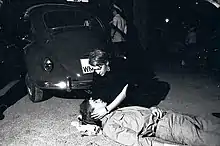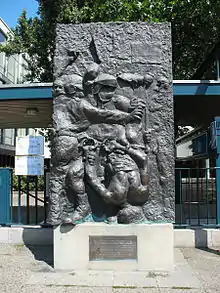Shooting of Benno Ohnesorg
Benno Ohnesorg (German pronunciation: [ˈbɛno ˈʔoːnəzɔɐ̯k]; 15 October 1940 – 2 June 1967)[1] was a West German university student killed by a policeman during a demonstration in West Berlin. His death spurred the growth of the left-wing German student movement.
Benno Ohnesorg | |
|---|---|
 Benno Ohnesorg (on the ground) shortly after being shot while a woman (above) tries to help him | |
| Born | 15 October 1940 |
| Died | 2 June 1967 (aged 26) |
| Alma mater | Freie Universität Berlin |
| Occupation | Student |
Incident
Protest
.jpg.webp)
On 2 June 1967, Ohnesorg participated in a student protest held near the Deutsche Oper, in opposition to the state visit of the Shah of Iran, Mohammad Reza Pahlavi, who was attending a performance of Mozart's The Magic Flute at the Deutsche Oper that night.[2][3] It was the first political demonstration in which Ohnesorg had ever taken part.
Violence and shooting
The protest turned violent after pro-Shah demonstrators, including agents of the Shah's intelligence service,[2] began battling with students, and the police overreacted, employing brutal tactics in their attempts to control the crowd.[4] In the ensuing tumult, demonstrators dispersed into the side streets.[2] In the courtyard of Krumme Straße 66, Ohnesorg was then shot by police officer Karl-Heinz Kurras.[2] Ohnesorg died before he could be treated at a hospital.[2] Kurras stood trial the same year and was acquitted, on 27 November 1967.[2][3] Ohnesorg was a student of Romance and German studies. He was married and his wife was pregnant with their first child.[5]
A week after Ohnesorg's death, a funeral caravan accompanied his coffin as it was transported from West Berlin through checkpoints in East Germany to his hometown of Hanover in West Germany, where he was buried.[6]
Re-investigation
More than forty years later, in 2009, it was revealed that at the time of the events Kurras had been an informal collaborator of the East German secret police Stasi, and a long-time member of the Socialist Unity Party of Germany, the ruling East German Communist party; however, the motive behind Kurras' act remains unclear.[4][7][8] The new information was based on documents discovered in the Stasi archives.[4] Initial reports indicated that the archives contained no evidence that Kurras was acting under Stasi orders when he shot Ohnesorg.[5][9]
On the basis of the 2009 revelations about Kurras, the German prosecutor's office initiated a new investigation, in order to clarify definitively whether there was any evidence that the killing of Ohnesorg could have been ordered by authorities in East Berlin; in November 2011 that investigation was officially closed, with the determination that there was not enough evidence to justify reopening the case.[10] The prosecutor's office noted that, due to the passage of time, many participants in the trial were either no longer alive or otherwise unable to provide reliable testimony; also, documents relevant to the case were evidently among those destroyed by the East German foreign intelligence service in the interval between the fall of the Berlin Wall, in 1989, and German reunification, in 1990.[10]
Following up in January 2012, Der Spiegel magazine reported that research carried out by federal prosecutors, as well as by the magazine, found that the shooting was not in self-defense as always claimed by Kurras and that it was certainly premeditated. Newly examined film and photographic evidence also implicated fellow officers and superiors, demonstrating that the police covered up the truth in subsequent investigations and trials. Additionally, medical staff who carried out the autopsy on Ohnesorg were ordered to falsify their report. However, the Spiegel report indicated that the new information was still unlikely to be sufficient for the case to be reopened.[11]
Legacy

Ohnesorg's death served as a rallying point for the left, and spurred the growth of the left-wing German student movement;[5] later, the Movement 2 June group (founded around 1971) was named for the day of his death.[4][12] Student activist Rudi Dutschke led student protest actions in the period following Ohnesorg's death.[13] Just after Ohnesorg's burial in Hanover, Dutschke, speaking at a conference held at the university there – under the rubric "The University and Democracy: Conditions and Organization of Resistance" – clashed with philosophy professor Jürgen Habermas over the future of the movement, with Dutschke advocating radical action that might include illegality and violence if necessary (though, in reality, his first proposed action was a peaceful sit-down strike); his intransigence prompted Habermas, who had urged a more moderate and pragmatic approach, famously to characterize Dutschke's ideology as amounting to "left fascism",[6] a formulation that he later retracted.[14][15] The student movement that swelled and, in part, became radicalised in the late 1960s, after Ohnesorg's death, influenced many future German politicians who were in their teens and twenties at the time.
A monument next to the Deutsche Oper Berlin, which was designed by Austrian sculptor Alfred Hrdlicka, serves as a memorial for the killing.[2] In December 2008, municipal authorities inaugurated an official memorial panel on the sidewalk in front of the house where Ohnesorg was shot.[2]
In Ohnesorg's hometown of Hanover, a bridge over the Ihme river is named after him.[1]
In film
The opening scene of the 2008 film Der Baader Meinhof Komplex shows Ohnesorg's death,[16] with the role of Ohnesorg played by Martin Glade.
See also
References
- Böttcher, Dirk (2002). "Ohnesorg, Benno" (in German), in: Hannoversches biographisches Lexikon: von den Anfängen bis in die Gegenwart. Hannover: Schlütersche. p. 275.
- "Gedenktafeln für Benno Ohnesorg" [Memorial plaques for Benno Ohnesorg] (in German). Bezirksamt Charlottenburg-Wilmersdorf. BerlinOnline Stadtportal (official Berlin website). berlin.de. Note: Includes a downloadable PDF document "Infotafel zur Erschießung Benno Ohnesorgs am 2. Juni 1967" with text in both German and English. Retrieved 1 June 2017.
- Rethmann, Petra (Winter 2006). "On Militancy, Sort Of". Cultural Critique. Vol. 62. pp. 67–91; here: p. 75. doi:10.1353/cul.2006.0008. Retrieved 1 June 2017 via Project Muse database.
- "Stasi Archive Surprise: East German Spy Shot West Berlin Martyr". Spiegel Online International. spiegel.de. 22 May 2009. Retrieved 1 June 2017.
- Kulish, Nicholas (26 May 2009). "Spy Fired Shot That Changed West Germany". New York Times. nytimes.com. Retrieved 1 June 2017.
- Berman, Russell A. (Summer 2008). "From 'Left-Fascism' to Campus Anti-Semitism: Radicalism as Reaction". Democratiya. pp. 14–30; here: pp. 15–16. Link to PDF available via Dissent Magazine. Retrieved 1 June 2017.
- Küpper, Mechthild (21 May 2009). "Stasi-Mitarbeiter erschoss Benno Ohnesorg" (in German). Frankfurter Allgemeine. faz.net. Retrieved 1 June 2017.
- "1968 Revisited: The Truth about the Gunshot that Changed Germany". Spiegel Online International. spiegel.de. 28 May 2009. Retrieved 1 June 2017.
- Beeg, Rena; Betz, Malte; Hellwig, Marcus; Nachtsheim, Katharina; and Uhlenbroich, Burkhard (10 July 2009). "Karl-Heinz Kurras: Gab Mielke ihm de Schießbefehl?" (in German). Bild. bild.de. Retrieved 1 June 2017. With photo gallery of the event as well as of Kurras and Ohnesorg.
- "Fall Ohnesorg zu den Akten gelegt" (in German). Frankfurter Rundschau. fr.de. 2 November 2011. Retrieved 1 June 2017.
- "Police Covered Up Truth Behind Infamous Student Shooting". Spiegel Online International. spiegel.de. 23 January 2012. Retrieved 25 February 2012.
- Rethmann (2006), pp. 76, 87.
- "West Berlin Gunman Wounds Leader of Left-Wing Students" (preview only; subscription required). New York Times. 12 April 1968. "It was Mr. Dutschke who led the Berlin students in their activities against the authorities following a shooting incident [in June 1967] in which a policeman shot and killed Benno Ohnesorg, another West Berlin student."
- DeGroot, Gerard J. (1998). Student Protest: The Sixties and After. London: Routledge. pp. 104–105.
- Ingram, David (2010). Habermas: Introduction and Analysis. Ithaca: Cornell University Press. p. 8, footnote 17.
- Kaplan, Fred (12 August 2009). "A Match That Burned the Germans" [review of the film The Baader Meinhof Complex]. New York Times. nytimes.com. Retrieved 1 June 2017.
External links
- Photograph of Benno Ohnesorg's death (Deutsches Historisches Museum)
- Short video about Ohnesorg's death, in English, with contemporary footage, in The Berlin Wall: A Multimedia History, RBB (Berlin-Brandenburg broadcaster)